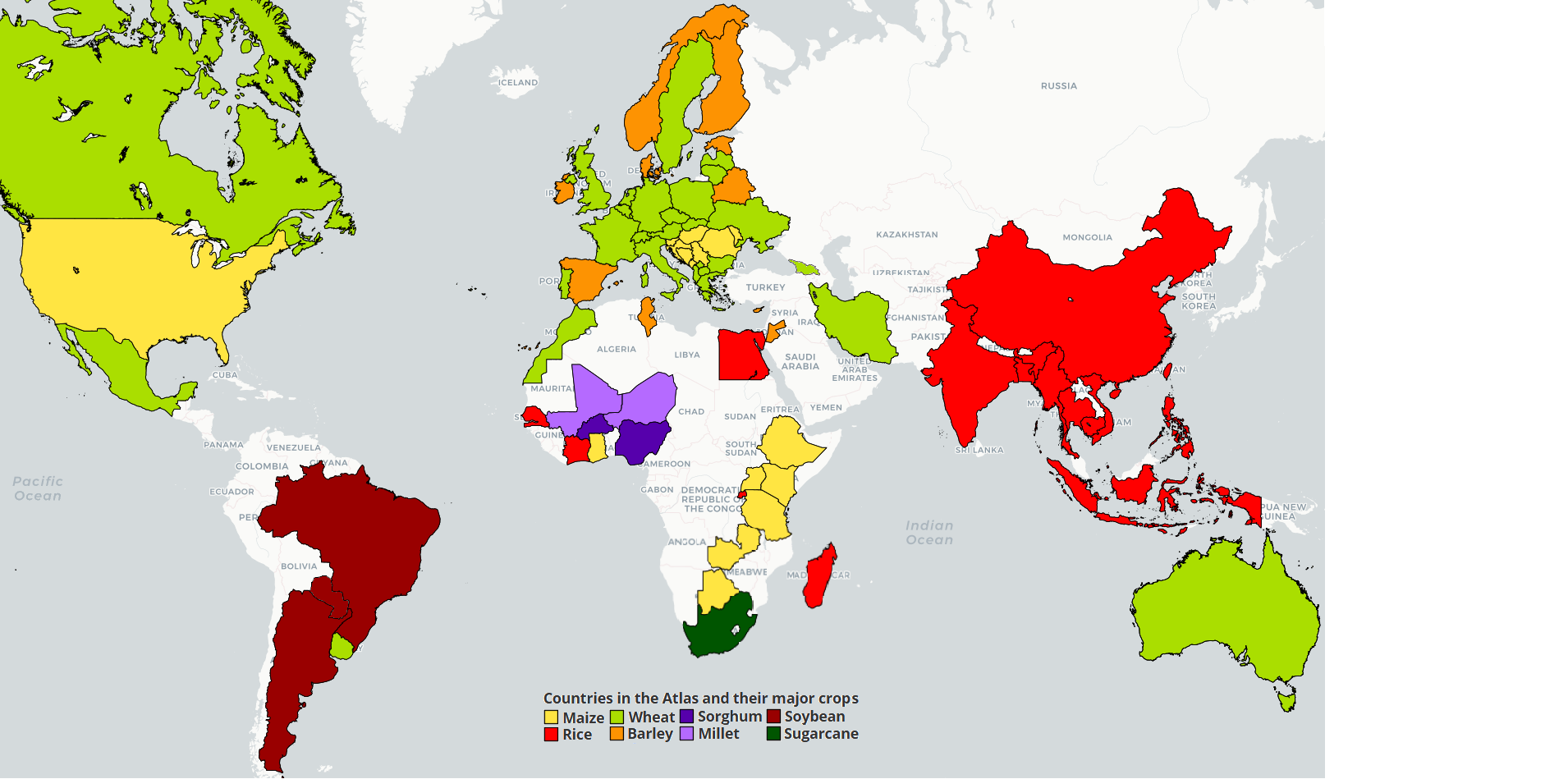 Tanzania
Tanzania
Detailed information on the analysis by crop is available for:
- Rice. Please check the sub-Saharan Africa rice page
- Wheat. Please check the sub-Saharan Africa wheat page
- Sorghum. Please check the sub-Saharan Africa sorghum page
- Millet. Please check the sub-Saharan Africa millet page
Description of cropping systems, climate, and soils in Tanzania (by Dr. J. Makoi)
Tanzania (excluding the islands of Zanzibar) has a total land area of 945,087 km2 including 61,000 km2 of inland water. Tanzania is the world's 31st-largest country and the 13th largest in Africa. Compared with other African countries, it is slightly smaller than Egypt and slightly larger than Nigeria.
According to the 2012 census, total population was 45 million (2012). Of this total, the under-15 age group represents 44 percen (PHC, 2013). Population distribution is extremely uneven, with density varying from 1 person/km2 in arid regions, to 51 persons/km2 in the well-watered highlands, to 134 person/km2 in Zanzibar. More than 80 percent of the population is rural.
Climate
Tanzania has a tropical climate and is divided into four main climatic zones: the hot humid coastal plain; the semi-arid central plateau; the high rainfall lake regions; and the temperate highlands. In the highlands, temperatures range from 10ºC and 20ºC during cool and warm seasons, respectively. The rest of the country has average temperatures rarely falling below than 20ºC. The hottest period occurs between November and February (25ºC - 31ºC) whereas the coldest period is often between May and August (15ºC - 20ºC). The climate is cool in high mountainous regions. Average maximum temperature is about 30ºC recorded during the hot season November to March, while average minimum temperature is 21ºC, recorded during the cool season of June to October. Humidity is often high ranging from 50% to 80%.
Tanzania has two major rainfall regimes. One is uni-modal (October–April) and the other is bi-modal (October–December and March–May). The former is experienced in southern, central, and western parts of the country, and the latter is found in the north from Lake Victoria extending east to the coast. The bi-modal regime is caused by the seasonal migration of the Intertropical Convergence Zone (ICZ) (Zorita & Tilya, 2002). In bi-modal areas, the October–December rains are generally known as the short rains or Vuli in Kiswahili. The March–May rains are referred to as the long rains or Masika. In the uni-modal areas, the rainy season is usually referred to as Musumi (TAS, 2003).
Tanzania is mountainous in the northeast, where Mount Kilimanjaro, Africa's highest peak, is situated. Three of Africa's Great Lakes are partly within Tanzania. To the north and west lie Lake Victoria, Africa's largest lake, and Lake Tanganyika, the continent's deepest lake, known for its unique species of fish. To the southwest lies Lake Nyasa. Central Tanzania is a large plateau, with plains and arable land. The eastern shore is hot and humid, with the Zanzibar Archipelago just offshore.
Agriculture
Tanzania has total area of 94.5 Mha of land, of which 44 Mha are classified as suitable for agriculture. Out of the available arable land only 10.1 Mha or 23 percent of is currently under cultivation. Agriculture in Tanzania is mainly rainfed and is dominated by smallholder farmers cultivating average farm sizes between 0.9 ha and 3.0 ha. About 70 percent of Tanzania's crop area is cultivated by hand hoe, 20 percent by ox plough and 10 percent by tractor. Food crop production dominates the agriculture economy, with 85 percent of the annually cultivated land under food crops. Women represent the majority of the agricultural labor force. Major constraints for agriculture in Tanzania are the decreasing labor and land productivities due to application of poor production technology and dependence on unreliable and irregular weather conditions.
With numerous rivers, lakes and underground water resources, Tanzania has huge potential for irrigated agriculture. Of the total arable land area, 29.4 Mha have varying degree of development potential for irrigation (NIMP, 2002): It is estimated that there is 2.3 Mha of high potential, 4.8 Mha of medium potential, and 22.3 Mha of low potential land for irrigation. The total area currently under irrigation is less than 0.5 Mha, of which only 0.4 Mha (1.2% of the total irrigation potential area) has good irrigation infrastructure, while another 0.1 Mha is still under traditional irrigation practice. The main irrigated crops are tea, sugar cane, coffee, flowers, grapes, fruits, maize, paddy, onions, tomatoes, vegetables, spices and pastures.
Agriculture is the largest sector in the Tanzanian economy represents about 27% of National Gross Domestic Product (GDP), 75% of exports, and provides employment for about 75% of the working population. Agriculture is linked to the non-farm sector through agro-processing, food consumption and export sectors, and provides raw materials to industry. Agricultural GDP has grew at 4.3% in 2012.
Tanzania has a considerable variation in farming systems due to the large variation in climatic and agro-ecological conditions. There are ten major farming systems in Tanzania (see Appendix A). Major staple and cash crops are listed in Table 1.
Table 1 Main Staple and Cash crops grown in Tanzania.
| Type of Crops | Crops |
| Staple crops | Maize, sorghum, millet, rice, wheat, beans, cassava, potatoes, bananas and plantains |
| Cash and Export crops | Coffee, cotton, cashew nuts, tobacco, sisal and pyrethrum, tea, cloves, horticultural crops, oil seeds, spices and flowers |
The national averages for total production, harvested area and yields of the major staple crops are given in Appendix B.
Major soil types
Data from PLDPT (1984) indicate that Tanzanian soils are related to the Agro-ecological Zones (AEZ) and strongly vary, as reported by De Pauw (1984) and NSS (2006). A simplified soil classification is as follows:
- Volcanic soils: These soils are of high agricultural potential. They predominate in Arusha, Kilimanjaro Regions, southwest Highlands, the Kitulo plateau. At high and medium altitudes, they zones are of importance for the production of dairy forage production.
- Light sandy soils: predominate in the coastal areas. They can be used for grazing during the rainy season but thereafter, these soils dry out rapidly and forage production becomes low and has poor quality.
- Soils of granite/gneiss origin: are poor and occur mainly in mid-west especially in Mwanza and Tabora.
- Red soils: occupy most of central plateau. They produce good forage in the short rainy season and the quality of forage is maintained into the dry season.
- Ironstone soils: are found in the far west, mainly in Kagera, Kigoma and Sumbawanga regions. They have poor inherent fertility and are acidic, but they can be made more productive with nutrient inputs, mulching and.or manuring.
- The mbuga black vertisols: These soils are widespread and are important for supplying forage during the dry season.
References
De Pauw, 1984. Soils, Physiography and agro-ecological zones of Tanzania. Crop Monitoring and early warning systems project. GCS/URT/047.NET. Ministry of Agricultural, Dar Es Salaam. Food and Agriculture Organization of the United Nations.
National Irrigation Master Plan (NIMP), 2002. Distribution of irrigation schemes in Tanzania
National Soil Service (NSS), 2006. Rainfed agriculture crop suitability for Tanzania. Mlingano agricultural research institute, Department of research and training, Ministry of Agriculture, Food Security and Co-operatives Tanga, Tanzania, November 2006
PLDPT, 1984. Proposal for livestock development programme for Tanzania.
Population and Housing Census of Tanzania (PHC). 2012. Population Distribution by Administrative Areas, National Bureau of Statistics, Ministry of Finance Dar es Salaam and Office of Chief Government Statistician President's Office, Finance, Economy and Development Planning Zanzibar. p. 264, March, 2013.
Tanzania Agricultural Seasons (TAS), 2003. Production Estimates and Crop Assessment Division, Foreign Agricultural Service, United States Department of Agriculture, 24 March 2003
Zorita E, Tilya FF, 2002. Rainfall variability in Northern Tanzania in the March–May season (long rains) and its links to large-scale climate forcing. Clim Res 20:31–40
Appendix A Major Farming Systems in Tanzania
| No. | Farming systems | Location of the systems | Remarks |
| 1 | Banana/Coffee/ Horticulture system | Kagera, Kilimanjaro, Arusha, Kigoma and Mbeya Regions | Tree crops, high intensive land use, volcanic soils with high fertility, land scarcity |
| 2 | Maize/Legume system | Rukwa, Ruvuma, Arusha, Kagera, Shinyanga, Iringa, Mbeya, Kigoma, Tabora, Tanga, Morogoro, Kahama, Biharamulo | Land not scarce, shifting cultivation, maize & legumes, beans and groundnuts intercropped, Arabic coffee |
| 3 | Cashew/Coconut/Cassava System | Coast region; eastern Lindi and Mtwara | Low rainfall, low soil fertility, cassava, coconut and cashew, land is not scarce, shifting cultivation |
| 4 | Rice/Sugar cane system | Alluvial river valleys | rice and sugarcanes |
| 5 | Sorghum/Bulrush millet/Livestock system | Sukumaland; Shinyanga and rural Mwanza | Sorghum, millet, maize and cotton, oilseeds and rice, intense population pressure, declining soil fertility |
| 6 | Tea/Maize/Pyrethrum system | Njombe and Mufindi districts in Iringa region | Tea, Maize, Irish potatoes, beans, wheat, pyrethrum, wattle trees and sunflower |
| 7 | Cotton/Maize system | Mwanza, Shinyanga Kagera, Mara, Singida, Tabora and Kigoma, Morogoro, Coast, Mbeya, Tanga, Kilimanjaro and Arusha | cotton, sweet potatoes, maize, sorghum and groundnuts, intensive cultivation, livestock kept |
| 8 | Horticulture based system | Lushoto district; Tanga region, Morogoro rural; Morogoro region and Iringa rural in Iringa region | Vegetables, (cabbages, tomatoes, sweet pepper, cauliflower lettuce and indigenous vegetables) and fruits, (pears, apples, plums, passion fruits and avocado), Maize, coffee, Irish potatoes, tea and beans |
| 9 | Wet – rice and irrigated system | river valleys and alluvial plains, Kilombero, Wami Valleys, Kilosa, Lower Kilimanjaro, Ulanga, Kyela, Usangu and Rufiji | |
| 10 | Pastoralists and Agropastoralist System | Semi-arid areas i.e. Dodoma, Singida, parts of Mara and Arusha; Chunya districts, Mbeya and Igunga district in Tabora | Deep attachment to livestock and simple cropping system , shifting cultivation of sorghum millet, moderate population density 30 per km2, limited resource base and poor and variable rainfall |
Appendix B National averages (for period 2005/06 - 2009/10) for the productions ('000' tons), harvested areas ('000' ha) and actual yields (tons/ha) of the major food crops in Tanzania
| Year | |||||||||||
| Crop | Data | 2005/2006 | 2006/2007 | 2007/2008* | 2008/2009 | 2009/2010 | |||||
| Banana | Area ( '000' ha) | 499.62 | 404.43 | - | 507.81 | 417.91 |
| ||||
| Production ( '000' tons) | 3,507.45 | 3,082.61 | - | 3,006.40 | 3,155.71 |
| |||||
| Yield (tons/ha) | 7.02 | 7.62 | - | 5.92 | 7.55 |
| |||||
| Beans | Area ( '000' ha) | 646.09 | 845.96 | 749.54 | 868.31 | 1,208.69 |
| ||||
| Production ( '000' tons) | 707.62 | 889.29 | 570.75 | 773.72 | 867.53 |
| |||||
| Yield (tons/ha) | 1.10 | 1.05 | 0.76 | 0.89 | 0.72 |
| |||||
| Bulrush millet | Area ( '000' ha) | 258.56 | 196.82 | 155.71 | 296.48 | 252.71 |
| ||||
| Production ( '000' tons) | 189.87 | 197.00 | 106.97 | 229.59 | 235.31 |
| |||||
| Yield (tons/ha) | 0.73 | 1.00 | 0.69 | 0.77 | 0.93 |
| |||||
| Cassava | Area ( '000' ha) | 993.17 | 779.07 | - | 1,081.38 | 873.00 |
| ||||
| Production ( '000' tons) | 6,158.30 | 5,198.93 | - | 5,916.44 | 4,547.94 |
| |||||
| Yield (tons/ha) | 6.20 | 6.67 | - | 5.47 | 5.21 |
| |||||
| Finger millet | Area ( '000' ha) | 64.61 | 70.18 | 58.26 | 102.03 | 93.15 |
| ||||
| Production ( '000' tons) | 56.79 | 110.90 | 42.55 | 82.83 | 115.56 |
| |||||
| Yield (tons/ha) | 0.88 | 1.58 | 0.73 | 0.81 | 1.24 |
| |||||
| Maize | Area ( '000' ha) | 2,570.99 | 2,600.35 | 3,980.97 | 2,961.33 | 3,050.71 |
| ||||
| Production ( '000' tons) | 3,423.03 | 3,302.06 | 5,438.78 | 3,326.20 | 4,733.07 |
| |||||
| Yield (tons/ha) | 1.33 | 1.27 | 1.37 | 1.12 | 1.55 |
| |||||
| Paddy | Area ( '000' ha) | 633.77 | 557.98 | 887.66 | 805.63 | 1,136.29 |
| ||||
| Production ( '000' tons) | 1,238.56 | 1,341.84 | 1,399.68 | 1,334.80 | 2,650.12 |
| |||||
| Yield (tons/ha) | 1.95 | 2.40 | 1.58 | 1.66 | 2.33 |
| |||||
| Sorghum | Area ( '000' ha) | 715.87 | 817.95 | 566.76 | 874.22 | 618.37 |
| ||||
| Production ( '000' tons) | 711.64 | 971.20 | 550.65 | 709.31 | 798.54 |
| |||||
| Yield (tons/ha) | 0.99 | 1.19 | 0.97 | 0.81 | 1.29 |
| |||||
| Sweet potatoes | Area ( '000' ha) | 590.47 | 511.02 | 204.50 | 651.94 | 576.22 |
| ||||
| Production ( '000' tons) | 2,606.04 | 2,466.52 | 410.96 | 1,417.39 | 2,424.20 |
| |||||
| Yield (tons/ha) | 4.41 | 4.83 | 2.01 | 2.17 | 4.21 |
| |||||
| Source: Statistics Unit-Ministry of Agriculture, Food Security and Cooperatives | |||||||||||
| *National Sample Census of Agriculture2007/2008 | |||||||||||
Legume production in East Africa
TanzaniaIn Tanzania several grain legume species are important grown. Common bean and groundnut are the most important ones in terms of area and production, followed by pigeon pea, cowpea and chickpea (FAOSTAT, MAFSC). Cowpea is mostly cultivated as subsistence crop in Tanzania, only a small proportion of the cowpea is sold. Pigeon pea is both a cash and food crop.
Approach for yield gap estimation of grain legumes in Ethiopia, Kenya and Tanzania
Harvested area and actual yields
Distribution of crop area as reported by SPAM 2005 maps (You et al., 2014a; 2014b) was used.
Actual yields for Ethiopia were based on nine year district level data obtained from the Central Statistical Agency Ethiopia (CSA-Ethiopia, 2004-2016); for Kenya a 5-year average centered on year 2005 was obtained from SPAM 2005 (You et al., 2014a; 2014b); and for Tanzania four years (2003, 2008, 2013, 2015) of district level data from the National Bureau of Statistics Tanzania were used (NBS-Tanzania, 2012; 2016a; 2016b).
Selected climate zones and Reference Weather Stations (RWS)
In our set of 3 countries, there were 14, 22, 11, 10 and 13 buffers selected for, in the same order, chickpea, common bean, cowpea, groundnut and pigeonpea. In turn, these buffers were located in, respectively, 6, 11, 7, 6, and 6 different climate zones, which, overall, accounted for respectively 52, 43, 75, 89, and 70% of east Africa harvested area with these crops.
Weather data
In the selected buffers, long-term (1998-2012) daily weather data were retrieved from the National Meteorology Agency of Ethiopia (NMA, 1998-2012), Tanzania Meteorological Agency (TMA, 1998-2012), and Kenya Meteorological Department (KMD, 1998-2012). Since 52% of the buffers had less than 10 years of weather data but at least 3 years, long weather data records were generated using the method described by Van Wart et al. (2015). Finally, for buffer zones without any measured weather data (48% of total buffers), we used uncorrected gridded weather data from NASA-POWER.
Soil data
Soil data were retrieved from both AfSIS-GYGA functional soil information of sub-Saharan Africa database (maximum effective depth of water extraction from soil by roots, maximum soil depth, volumetric soil water content available for extraction by crop roots) (Leenaars et al., 2015; Leenaars et al., 2018) and ISRIC-World soil information, WISE international soil profile dataset (drainage) (Batjes, 2012).
Crop modelling
Water-limited potential yields were estimated using the generic crop growth model Simple Simulation Model for legumes (SSM-legumes) (Soltani and Sinclair, 2012; https://sites.google.com/site/cropmodeling/-7-ssm-soybean). The SSM model has been used to simulate growth and yield potential of a wide range of legume crops, including soybean (Sinclair et al., 2014; Sinclair et al., 2010), chickpea (Soltani and Sinclair, 2011; Vadez et al., 2013), common bean (Marrou et al., 2014), lentil (Ghanem et al., 2015), cowpea (Hissene et al., 2016), and groundnut (Halilou et al., 2016).
We collected the value of general plant parameters from previous model applications (Sinclair et al., 2010, 2014; Soltani and Sinclair, 2011; Vadez et al., 2013; Marrou et al., 2014; Ricaurte et al 2015; Guiguitant et al., 2017; Manandhar et al., 2017). In each of these studies, genotypes have been sampled to represent the diversity of genotypes used in each study environment, covering temperate, dry tropical, and humid tropical climates. Most plant parameters are known from preceding studies not to vary significantly within species. For the crop specific parameters, phenology and photoperiod sensitivity, we calculated them to portray the varieties grown in east Africa, by using the parameter values of genotypes of the same variety in preceding studies, or calculating them from the phenology reported by local agronomists.
More details and references are presented in: Loon, Marloes P. van , Nanyan Deng, Patricio Grassini, Juan I. Rattalino Edreira, Endalkachew Wolde-meskel, Frederick Baijukya, Hélène Marrou, Martin K. van Ittersum. 2018. Prospect for increasing grain legume crop production in East Africa. European Journal of Agronomy. Vol. 101 (November 2018), 140-148; https://doi.org/10.1016/j.eja.2018.09.004
Get access to the Atlas for advanced users
Download GYGA results
 | Please read the license information in case you are interested in using the data from the Global Yield Gap Atlas. |
| read more>> |



